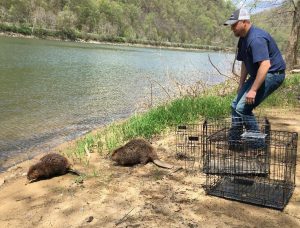Share this article
Moving beaver for property and natural resource protection
This spring a property protection issue emerged allowing me to revisit my earliest work with USDA’s Wildlife Services, but with a northern perspective. My first position with the damage management program in South Carolina saw an extensive portion of my time managing beaver damage to protect transportation infrastructure and agriculture. Usually this meant trapping beaver ponds and removing dams that threatened roadways, bridges and various agricultural crops. With statewide abundant beaver populations, no locations existed for relocation.
In April, wildlife technician Amy Hess, CWB, learned that beaver activity had totally blocked a 6-foot box culvert running under a state road built on a 30-foot high berm. The owner, an energy company, manages large acreage around a dam and resulting lake upstream from the culvert. It wanted to address the potential for undermining the roadway before it became a problem for the Pennsylvania Department of Transportation.

Wildlife Services biologist Craig Hicks encourages beaver pair to explore their new territory, approved for them by the Pennsylvania Game Commission.
©USDA Wildlife Services
Keystone Lake, in Armstrong County, serves as a cooling water source for Keystone Power Plant but also offers 850 acres of shallows, wetlands and deeper-water fishing for bass, walleye, trout (stocked) and other fish. Several thousand surrounding acres are open for hunting. Although the company prefers nonlethal management, we determined a pond leveler would not function well given the culvert length and general topography.
My current position as a Wildlife Services supervisory biologist keeps me behind a desk more than any wildlifer wants, and this offered an irresistible field opportunity. The Pennsylvania Game Commission allows state game wardens to make beaver relocation decisions in their respective assignment areas. With the OK from the local state game warden, Amy and I set six snares and within a day captured a pair of big, healthy beavers. Wildlife biologist Tim Linder and I transferred them about 15 miles west to a release site approved by the game commission along the Allegheny River. It took Amy, wildlife technician Brian Zahuranic and me five days of intermittent work to completely disassemble the extensive dam inside the almost 200-foot-long culvert, where water is still flowing freely a month later.
Through cooperation with the state agency and support of the requesting company, the Wildlife Services team in western Pennsylvania appreciates the opportunity to relocate beaver, protecting property while allowing for continued hunting and trapping opportunities in the Keystone State.
To see a video, click here.
Wildlife Services is a Strategic Partner of TWS.
Header Image: A beaver awaits transport to a new location 15 miles away. ©USDA Wildlife Services








